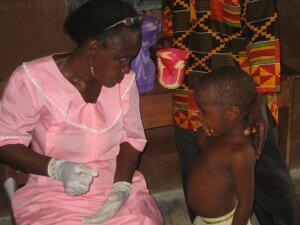Emily Cotter is a second-year medical student at George Washington University in Washington DC. This summer, through Global Network founding collaborator Helen Keller International, Emily worked on NTDs in Sierra Leone. Below is the final installment of her 4-part series detailing her experiences.
After working on the public health side of NTD control projects earlier in the summer, I thought it would be interesting to see the clinical side of the NTD world. Emmanuel, a Community Health Officer student (essentially the equivalent of a medical student) who works closely with HKI staff on NTD projects, was scheduled to work at a clinic in July. I decided to shadow him at the clinic for a couple of weeks, which brought me to Bo, the second-largest city in Sierra Leone.
The health care system in Sierra Leone is all fee-for-service. In many areas of the country the average income is $0.11 per day and the cost of seeing a health care provider is usually at least a couple of dollars. Due to this, most people don’t get the care they need and if they do visit the healthcare system they present very late when it is usually a dire emergency. Médecins Sans Frontièrs (MSF, also known as Doctors Without Borders) has been working in Sierra Leone since the beginning of the country’s civil war and supports a few clinics around Bo. The government runs these primary care clinics; however, MSF provides the medications and covers the patient fees at these clinics while also operating a secondary health care referral center. This referral center can accommodate minor surgeries and monitor cases of severe malaria, malnutrition and other complex health problems. Emmanuel was placed at one of the MSF-supported primary care clinics for his practical experience and I was very excited to have a chance to learn more about their operations on the ground – I’ve wanted to work with MSF for more than a decade!
Most of the pediatric patients who came to the clinic were either infected with Plasmodium falciparum (malaria) or were extremely malnourished. The rainy season had begun in Sierra Leone, which I learned brings with it malaria and malnutrition season. MSF operates both in-patient and outpatient therapeutic feeding programs so I saw quite a few very sick kids being treated for marasmus and kwashiorkor (different types of malnutrition). I was continually struck by the contrast between the health problems in the United States relating to obesity and the other side of the hunger spectrum that I witnessed in Sierra Leone.
There was an “unholy trinity” of childhood anemia etiologies: malaria, malnutrition, and helminth infections ravaged children and left many severely anemic. Some children had dangerously low hemoglobin levels – from 4.2 g/dl to 3.2 g/dl, and even as low as 2.5 g/dl! (Hemoglobin levels should be above 12 or 13 g/dl; it is usually considered an emergency if they fall below 7 g/dl.). A young child actually died at the clinic one day; she was incredibly anemic, had severe malaria, and went into heart failure. Clinic health care workers typically send the kids with low hemoglobin levels to the MSF referral center where the children receive a blood transfusion. Given the lack of infrastructure and reliable access to electricity, no large blood bank exists in Sierra Leone. Instead, parents are asked to donate blood for their kids if their blood type matches. Another child with a dangerously low hemoglobin level came to the clinic the afternoon the girl died and no family member was able to donate blood for her. Being O+ and an almost-universal donor, I gave a pint of my blood for her. The blood draw was not the greatest, so for the subsequent two weeks my bruise was a visible reminder of the devastation of tropical diseases in this region of West Africa.


 It was fascinating to see the implementation of such a large-scale public health campaign! Sierra Leone has previously implemented PCT campaigns for other diseases such as onchocerciasis, lymphatic filariasis and soil-transmitted helminths using an approach called Community-Directed Treatment with Ivermectin. This approach uses community-based drug distributors who are trained volunteers that distribute ivermectin and albendazole in their communities. The PCT campaign for schistosomiasis did not use these volunteers; instead, the Ministry of Health and Sanitation trained the peripheral health unit staff to distribute praziquantel using a height-pole for accurate dosing. Mebendazole was also given to children during this campaign so children were simultaneously treated for soil-transmitted helminths and schistosomiasis. Praziquantel needs to be given with food so funding was also distributed to provide a meal at school before children were given the medications.
It was fascinating to see the implementation of such a large-scale public health campaign! Sierra Leone has previously implemented PCT campaigns for other diseases such as onchocerciasis, lymphatic filariasis and soil-transmitted helminths using an approach called Community-Directed Treatment with Ivermectin. This approach uses community-based drug distributors who are trained volunteers that distribute ivermectin and albendazole in their communities. The PCT campaign for schistosomiasis did not use these volunteers; instead, the Ministry of Health and Sanitation trained the peripheral health unit staff to distribute praziquantel using a height-pole for accurate dosing. Mebendazole was also given to children during this campaign so children were simultaneously treated for soil-transmitted helminths and schistosomiasis. Praziquantel needs to be given with food so funding was also distributed to provide a meal at school before children were given the medications. Emily Cotter is a second-year medical student at George Washington University in Washington DC. This summer, through Global Network founding collaborator Helen Keller International, Emily worked on NTDs in Sierra Leone. Below is part 2 of her 4-part series detailing her experiences.
Emily Cotter is a second-year medical student at George Washington University in Washington DC. This summer, through Global Network founding collaborator Helen Keller International, Emily worked on NTDs in Sierra Leone. Below is part 2 of her 4-part series detailing her experiences.